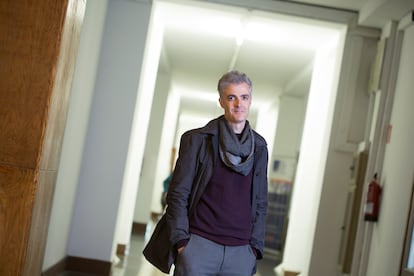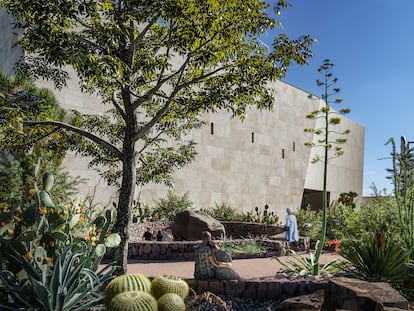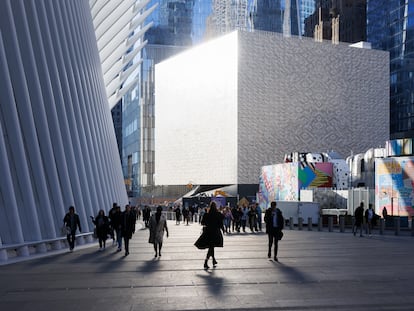Álvaro Sevilla-Buitrago, urban planner: ‘Central Park was born to eliminate community life’
The architecture scholar from Madrid’s Polytechnic University explores the role of spatial planning in the destruction of cooperative living systems

Álvaro Sevilla-Buitrago, 45, has overhauled the textbooks that he once used to study architecture. In his book Against the Commons: A Radical History of Urban Planning, this professor of urban studies at Madrid’s Polytechnic University’s School of Architecture has amended the treaties on the origins of spatial planning. Contrary to common belief, he argues that this discipline did not emerge at the end of the 19th century in the large cities, but a century earlier in rural areas. And more specifically in England, where the system known as the commons came to an end with the land enclosures that Karl Marx later placed at the origin of capitalism. Published last year in English by the University of Minnesota and now also available in Spanish, the essay explores the dark side of urban planning, including its role in the destruction of cooperative life. And he does so with the example of four historical episodes crisscrossed by social change.
Question. You deny that urban planning emerged to limit the excesses of the market, as is usually taught in colleges.
Answer. The Inclosure Acts of the 18th century in England were born with the objective of privatizing communal land and ending the regulation of local life and cultivation patterns by the community. Those laws had a lot to do with the spatial planning tools that we know today: they were exposed to the public, were supported by cartography, and gave rise to a professional body of surveyors.
Q. Jumping forward in time, you describe a similar effect of dispossession in the residential areas built for workers on the outskirts of Berlin in the 1920s.
A. The popular neighborhoods had grown a lot in the last third of the 19th century. There, small manufacturing workshops were mixed with homes, businesses and leisure spaces. Linked to this rich and complex life, forms of antagonism began to emerge that triggered the Spartacist Uprising and other outbreaks. Faced with this, the residential complexes promoted by unions or the City Council operated with a minimum threshold of sociability. They were on the outskirts, deprived of that entire network of services and activities.
Q. An example of these projects is the Hufeisensiedlung neighborhood, designed by Bruno Taut, a socialist symbol that was declared a World Heritage Site. It can’t be that bad.
A. Those were heroic moments for architecture. The modern avant-garde had never had access to contracts as relevant as they did then. Therefore, at the level of design and heritage they are very unique buildings, but things change if we look at the sociology of the environment: they contributed to disempowering communities.
Q. Just like Central Park, you say in your book.
A. The public ownership of a space does not ensure that it is at the service of the community. Central Park was promoted in New York as a democratic park, but in reality it was born as one of the first initiatives to eliminate community life from the peri-urban area of Manhattan. Its opening was accompanied by ordinances that prohibited reasonable things, such as carrying weapons, but also other common practices in popular neighborhoods. This is the case of street vending, gambling, alcohol consumption or political speeches. Those were the days when [anarchist writer and orator] Emma Goldman could be heard delivering addresses standing on a box.
Q. Urban planners then experience cognitive dissonance? They generate effects different from those that were desired?
A. Conventional practice unfortunately strays from the luminous image that we find in canonical texts.
Q. It will demoralize your students.
A. I think not. Many are aware that there is a chasm between theory and practice. It is enough to walk through the vast majority of the developments of the last two or three decades. They are designed for minimal sociability.
Q. Is there any urban planning that contributes to creating a sense of community?
A. In the U.S. and other places it is called radical planning. The urban planner puts his skills and technical competencies at the service of the community, acting as a facilitator. Students are increasingly interested in this model. Then they do what they can when they go out there and encounter public administrations that are often at the service of the market.
Q. Isn't it more urgent to design cities that tackle climate change?
A. States are a fundamental piece in social and environmental justice, but there are more and more people arguing that the social scale is also important. When communities acquire collective control of resources on which their subsistence depends, they prove to be much more effective in preserving territory or ecosystems than other actors such as state agencies or the market.
Sign up for our weekly newsletter to get more English-language news coverage from EL PAÍS USA Edition
Tu suscripción se está usando en otro dispositivo
¿Quieres añadir otro usuario a tu suscripción?
Si continúas leyendo en este dispositivo, no se podrá leer en el otro.
FlechaTu suscripción se está usando en otro dispositivo y solo puedes acceder a EL PAÍS desde un dispositivo a la vez.
Si quieres compartir tu cuenta, cambia tu suscripción a la modalidad Premium, así podrás añadir otro usuario. Cada uno accederá con su propia cuenta de email, lo que os permitirá personalizar vuestra experiencia en EL PAÍS.
¿Tienes una suscripción de empresa? Accede aquí para contratar más cuentas.
En el caso de no saber quién está usando tu cuenta, te recomendamos cambiar tu contraseña aquí.
Si decides continuar compartiendo tu cuenta, este mensaje se mostrará en tu dispositivo y en el de la otra persona que está usando tu cuenta de forma indefinida, afectando a tu experiencia de lectura. Puedes consultar aquí los términos y condiciones de la suscripción digital.
More information

Mexico builds largest environmental sciences museum in Latin America
Últimas noticias
Maduro pleads not guilty before the federal court in New York: ‘I am still the president of Venezuela’
A new test can detect Alzheimer’s from a finger prick
UN team enters Sudanese city of El Fasher after paramilitary massacre: ‘It’s like a ghost town’
A recipe for resistance: Indigenous peoples politicize their struggles from the kitchen
Most viewed
- Gilles Lipovetsky: ‘If you want to live better and fall in love, take Prozac, don’t look to philosophy’
- Alain Aspect, Nobel laureate in physics: ‘Einstein was so smart that he would have had to recognize quantum entanglement’
- Alvin Hellerstein, a 92-year-old judge appointed by Bill Clinton, to preside over Maduro’s trial in New York
- Why oil has been at the center of Venezuela-US conflicts for decades
- Maduro’s downfall puts China’s relationship with Venezuela to the test










































